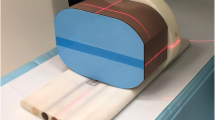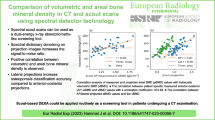Abstract
Objectives
To develop and evaluate a method for areal bone mineral density (aBMD) measurement based on dual-layer spectral CT scout scans.
Methods
A post-processing algorithm using a pair of 2D virtual mono-energetic scout images (VMSIs) was established in order to semi-automatically compute the aBMD at the spine similarly to DXA, using manual soft tissue segmentation, semi-automatic segmentation for the vertebrae, and automatic segmentation for the background. The method was assessed based on repetitive measurements of the standardized European Spine Phantom (ESP) using the standard scout scan tube current (30 mA) and other tube currents (10 to 200 mA), as well as using fat-equivalent extension rings simulating different patient habitus, and was compared to dual-energy X-ray absorptiometry (DXA). Moreover, the feasibility of the method was assessed in vivo in female patients.
Results
Derived from standard scout scans, aBMD values measured with the proposed method significantly correlated with DXA measurements (r = 0.9925, p < 0.001), and mean accuracy (DXA, 4.12%; scout, 1.60%) and precision (DXA, 2.64%; scout, 2.03%) were comparable between the two methods. Moreover, aBMD values assessed at different tube currents did not differ significantly (p ≥ 0.20 for all), suggesting that the presented method could be applied to scout scans with different settings. Finally, data derived from sample patients were concordant with BMD values from a reference age-matched population.
Conclusions
Based on dual-layer spectral scout scans, aBMD measurements were fast and reliable and significantly correlated with the according DXA measurements in phantoms. Considering the number of CT acquisitions performed worldwide, this method could allow truly opportunistic osteoporosis screening.
Key Points
• 2D scout scans (localizer radiographs) from a dual-layer spectral CT scanner, which are mandatory parts of a CT examination, can be used to automatically determine areal bone mineral density (aBMD) at the spine.
• The presented method allowed fast (< 25 s/patient), semi-automatic, and reliable DXA-equivalent aBMD measurements for state-of-the-art DXA phantoms at different tube settings and for various patient habitus, as well as for sample patients.
• Considering the number of CT scout scan acquisitions performed worldwide on a daily basis, the presented technique could enable truly opportunistic osteoporosis screening with DXA-equivalent metrics, without involving higher radiation exposure since it only processes existing data that is acquired during each CT scan.





Similar content being viewed by others
Abbreviations
- ANCOVA:
-
Analysis of covariance (a statistical analysis technique)
- AP:
-
Antero-posterior
- BMC:
-
Bone mineral content (g)
- BMD:
-
Bone mineral density (mg/mL), sometimes also used for areal bone mineral density (aBMD, g/cm2)
- CV:
-
Coefficient of variation
- DXA, DEXA:
-
Dual-energy X-ray absorptiometry
- ESP:
-
European Spine Phantom
- HA:
-
Calcium-hydroxyapatite, the main mineral component of bone
- IV:
-
Intravenous (contrast agent)
- QCT:
-
Quantitative computed tomography
- VMSI:
-
Virtual mono-energetic scout image
References
Hernlund E, Svedbom A, Ivergård M et al (2013) Osteoporosis in the European Union: medical management, epidemiology and economic burden: a report prepared in collaboration with the International Osteoporosis Foundation (IOF) and the European Federation of Pharmaceutical Industry Associations (EFPIA). Arch Osteoporos 8:136
Häussler B, Gothe H, Göl D, Glaeske G, Pientka L, Felsenberg D (2007) Epidemiology, treatment and costs of osteoporosis in Germany - the BoneEVA study. Osteoporos Int 18(1):77–84
Glüer CC (2017) 30 years of DXA technology innovations. Bone 104:7–12. https://doi.org/10.1016/j.bone.2017.05.020
Curtis JR, Carbone L, Cheng H et al (2008) Longitudinal trends in use of bone mass measurement among older Americans, 1999-2005. J Bone Miner Res 23(7):1061–1067
Link TM (2012) Osteoporosis imaging: state of the art and advanced imaging. Radiology 263(1):3–17. https://doi.org/10.1148/radiol.12110462
Brett AD, Brown JK (2015) Quantitative computed tomography and opportunistic bone density screening by dual use of computed tomography scans. J Orthop Translat 3(4):178–184. https://doi.org/10.1016/j.jot.2015.08.006
Damilakis J, Adams JE, Guglielmi G, Link TM (2010) Radiation exposure in X-ray-based imaging techniques used in osteoporosis. Eur Radiol 20(11):2707–2714
Schwaiger BJ, Kopperdahl DL, Nardo L et al (2017) Vertebral and femoral bone mineral density and bone strength in prostate cancer patients assessed in phantomless PET/CT examinations. Bone 101:62–69. https://doi.org/10.1016/j.bone.2017.04.008
Patel AA, Maver DW, Siegel EL (2010) The CT scout exam: a survey of radiation dose, utilization, and opportunity for substantial dose reduction. In: Radiological Society of North America 2010 Scientific Assembly and Annual Meeting. Chicago
Bohrer E, Schäfer S, Mäder U, Noël PB, Krombach GA, Fiebich M (2017) Optimizing radiation exposure for CT localizer radiographs. Z Med Phys 27(2):145–158. https://doi.org/10.1016/j.zemedi.2016.09.004
Schmidt B, Saltybaeva N, Kolditz D, Kalender WA (2013) Assessment of patient dose from CT localizer radiographs. Med Phys 40(8):084301
Alvarez RE, Macovski A (1976) Energy-selective reconstructions in X-ray computerised tomography. Phys Med Biol 21(5):2 Available from: http://stacks.iop.org/0031-9155/21/i=5/a=002?key=crossref.9250d07732e8ba4c630ab8afe8ccd214
van Hamersvelt RW, Schilham AMR, Engelke K et al (2017) Accuracy of bone mineral density quantification using dual-layer spectral detector CT: a phantom study. Eur Radiol 27(10):4351–4359
Mei K, Schwaiger BJ, Kopp FK et al (2017) Bone mineral density measurements in vertebral specimens and phantoms using dual-layer spectral computed tomography. Sci Rep 7(1):1–10
McCollough CH, Leng S, Yu L, Fletcher JG (2015) Dual- and multi-energy CT: principles, technical approaches, and clinical applications. Radiology 276(3):637–653
Vlassenbroek A (2011) Dual layer CT. In: Johnson T, Fink C, Schönberg S, Reiser M (eds) Dual Energy CT in Clinical Practice. Medical Radiology. Springer, Berlin, Heidelberg, pp 21–34
Ehn S, Sellerer T, Muenzel D et al (2018) Assessment of quantification accuracy and image quality of a full-body dual-layer spectral CT system. J Appl Clin Med Phys 19(1):204–217
Carmi R, Naveh G, Altman A (2005) Material separation with dual-layer CT. IEEE Nucl Sci Symp Conf Rec 4:1876–1878
Kalender WA, Felsenberg D, Genant HK, Fischer M, Dequeker J, Reeve J (1995) The European Spine Phantom - a tool for standardization and quality control in spinal bone mineral measurements by DXA and QCT. Eur J Radiol 20(2):83–92
Yu EW, Thomas BJ, Brown JK, Finkelstein JS (2012) Simulated increases in body fat and errors in bone mineral density measurements by DXA and QCT. J Bone Miner Res 27(1):119–124
Wu XP, Liao EY, Huang G, Dai RC, Zhang H (2003) A comparison study of the reference curves of bone mineral density at different skeletal sites in native Chinese, Japanese, and American Caucasian women. Calcif Tissue Int 73(2):122–132
Bonnick SL (2008) Monitoring changes in bone density. Womens Health (Lond) 4(1):89–97. https://doi.org/10.2217/17455057.4.1.89
Aubert B, Vazquez C, Cresson T, Parent S, De Guise J (2016) Automatic spine and pelvis detection in frontal X-rays using deep neural networks for patch displacement learning. Proc - Int Symp Biomed Imaging; 2016–June:1426–9
Pourmorteza A, Symons R, Sandfort V et al (2016) Abdominal imaging with contrast-enhanced photon-counting CT: first human experience. Radiology 279(1):239–245. https://doi.org/10.1148/radiol.2016152601
Taguchi K, Iwanczyk JS (2013) Vision 20/20: single photon counting x-ray detectors in medical imaging. Med Phys 40(10):100901. https://doi.org/10.1118/1.4820371
Muenzel D, Bar-Ness D, Roessl E et al (2016) Spectral photon-counting CT: initial experience with dual–contrast agent K-edge colonography. Radiology 283(3):723–728
Gutjahr R, Halaweish AF, Yu Z et al (2016) Human imaging with photon-counting-based CT at clinical dose levels: contrast-to-noise ratio and cadaver studies. Invest Radiol 51(7):421–429
Willemink MJ, Persson M, Pourmorteza A, Pelc NJ, Fleischmann D (2018) Photon-counting CT: technical principles and clinical prospects. Radiology 172656. https://doi.org/10.1148/radiol.2018172656
Dangelmaier J, Bar-Ness D, Daerr H et al (2018) Experimental feasibility of spectral photon-counting computed tomography with two contrast agents for the detection of endoleaks following endovascular aortic repair. Eur Radiol 28(8):3318–3325
Cormode DP, Si-Mohamed S, Bar-Ness D et al (2017) Multicolor spectral photon-counting computed tomography: in vivo dual contrast imaging with a high count rate scanner. Sci Rep 7(1):1–11
Funding
We acknowledge support through QRM for providing the ESP phantom, the German Department of Education and Research (BMBF) under grant IMEDO (13GW0072C), the German Research Foundation (DFG - Gottfried Wilhelm Leibniz program), and the DFG within the Research Training Group GRK 2274.
K.B, L.C.F., and R.P. are employees of Philips. The remaining authors have no financial disclosures and had complete, unrestricted access to the study data at all stages of the study.
Author information
Authors and Affiliations
Corresponding author
Ethics declarations
Guarantor
The scientific guarantor of this publication is PD Dr. Peter B. Noël.
Conflict of interest
The authors of this manuscript declare no relationships with any companies, whose products or services may be related to the subject matter of the article.
Statistics and biometry
One of the authors has significant statistical expertise. No complex statistical methods were necessary for this paper.
Informed consent
Written informed consent was waived by the Institutional Review Board.
Ethical approval
Institutional Review Board approval was obtained.
Methodology
• prospective
• diagnostic study/experimental
• performed at one institution
Additional information
Publisher’s wote
Springer Nature remains neutral with regard to jurisdictional claims in published maps and institutional affiliations.
Summary statement
The presented method, based on spectral CT scout scans, allows to reliably determine areal BMD in state-of-the-art phantom and in sample patient data. The results suggest that the performance of the method is possibly similar to that of DXA for the phantom experiments performed in this work.
Electronic supplementary material
ESM 1
(DOCX 24 kb)
Rights and permissions
About this article
Cite this article
Laugerette, A., Schwaiger, B.J., Brown, K. et al. DXA-equivalent quantification of bone mineral density using dual-layer spectral CT scout scans. Eur Radiol 29, 4624–4634 (2019). https://doi.org/10.1007/s00330-019-6005-6
Received:
Revised:
Accepted:
Published:
Issue Date:
DOI: https://doi.org/10.1007/s00330-019-6005-6




